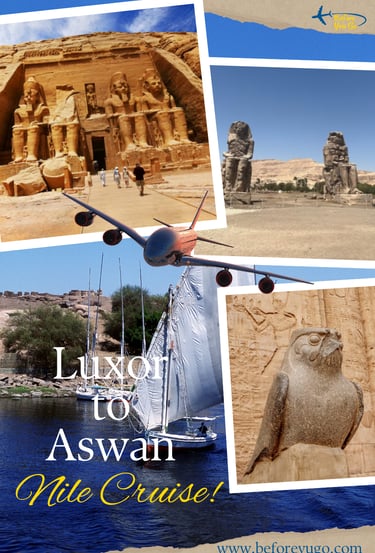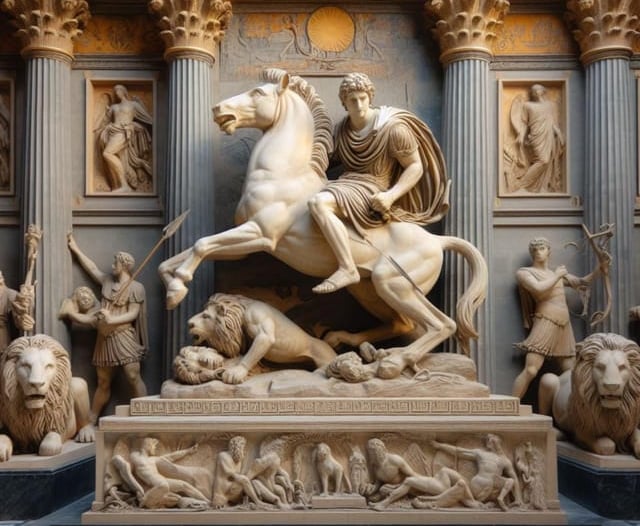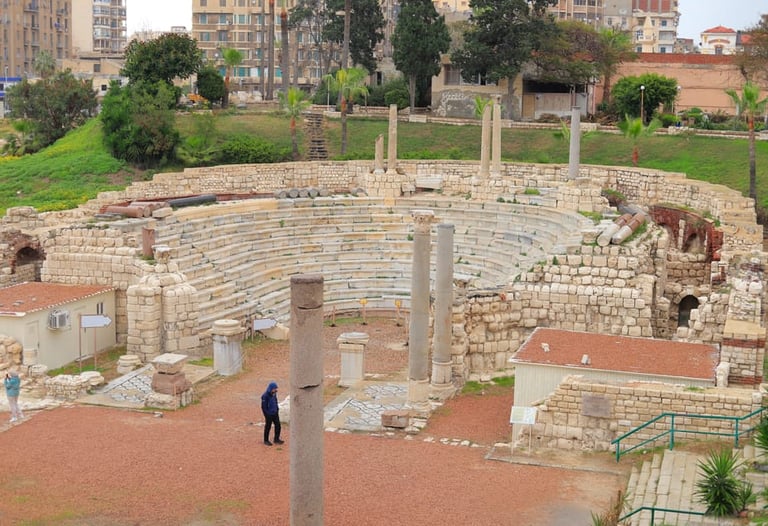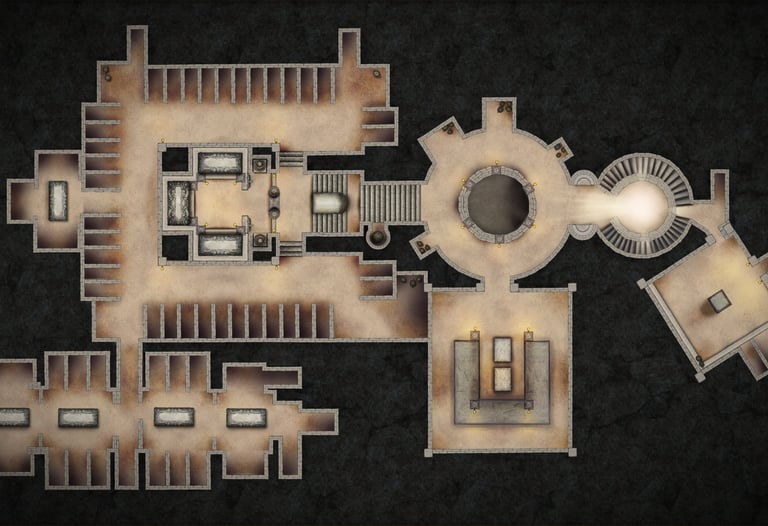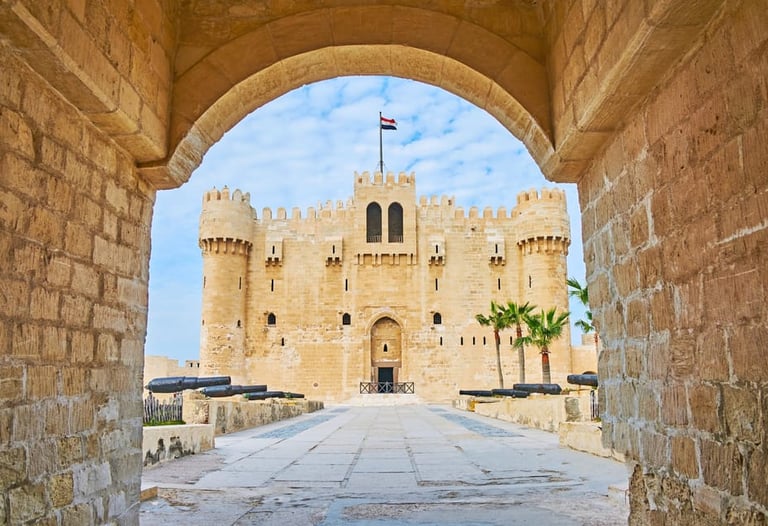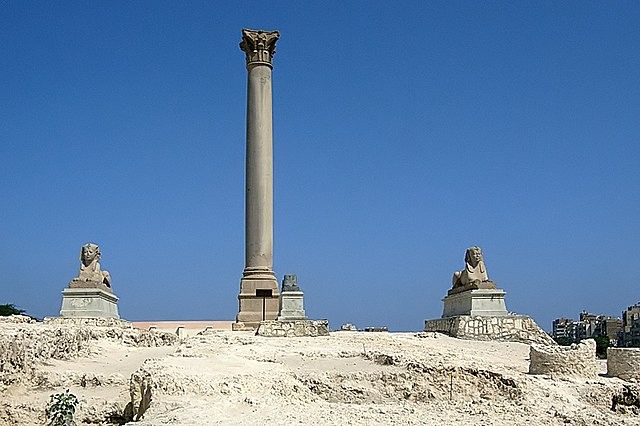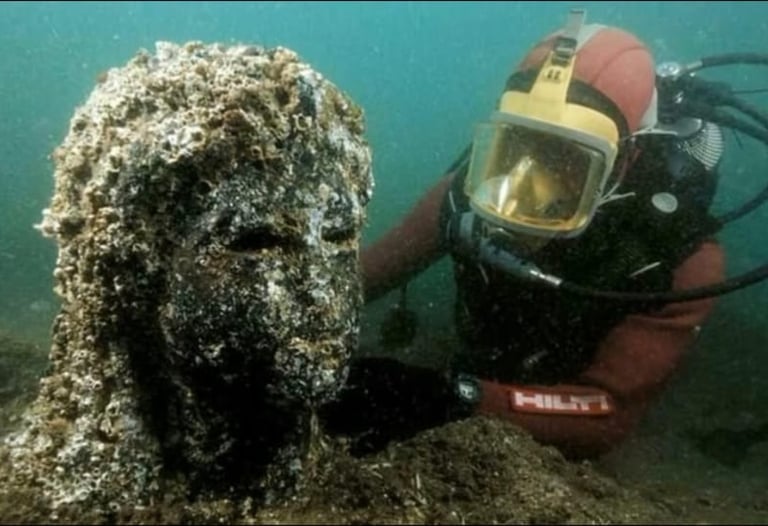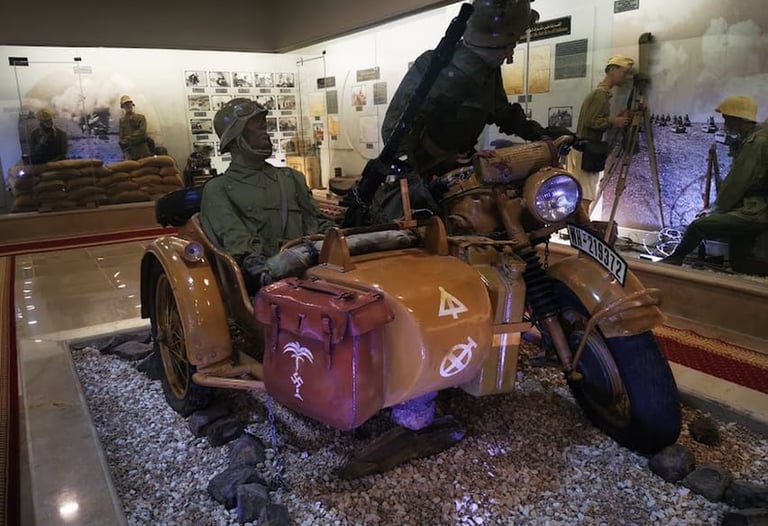Unearthing Alexandria's Ancient Wonders
Explore Alexandria's ancient wonders, from the Graeco-Roman Museum to El Alamein battlefields.
EGYPT
12 min read
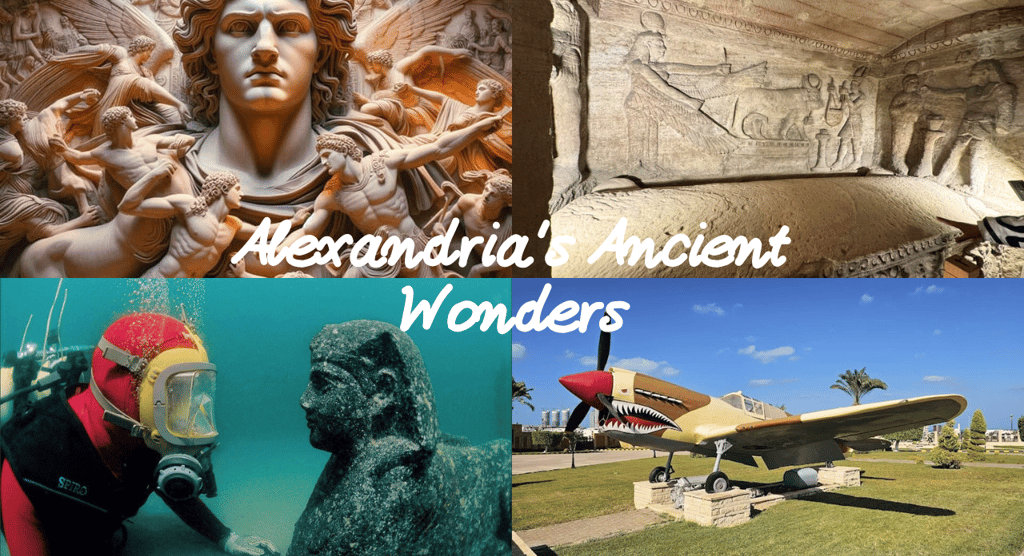

Nestled along Egypt's Mediterranean coastline, Alexandria is a city where ancient history whispers from every corner. Founded by Alexander the Great in 331 BC, this storied metropolis became a beacon of Hellenistic culture and Roman influence. Today, its rich tapestry of Egyptian, Greek, and Roman heritage beckons travelers seeking a deep dive into antiquity.
In this guide, we'll traverse Alexandria's most captivating historical and archaeological sites, offering insights and practical tips to enrich your journey. From the treasures of the Graeco-Roman Museum to the solemn grounds of El Alamein, prepare to embark on an unforgettable exploration of Alexandria's ancient wonders.
Exploring the Graeco-Roman Museum
The Graeco-Roman Museum stands as a testament to Alexandria's illustrious past. Established in 1892, this museum houses an extensive collection of artifacts that illuminate the fusion of Greek, Roman, and Egyptian cultures.
Visitors can marvel at sculptures, pottery, jewelry, and coins that narrate tales of a bygone era. Highlights include statues of ancient deities, intricate mosaics, and relics from the Ptolemaic dynasty. The museum's 27 exhibition rooms offer a comprehensive journey through Alexandria's multifaceted history.
A Full-Day Journey Through Alexandria's Ancient Landmarks
1- Roman Amphitheater of Kom El-Deka
Begin your day at the Roman Amphitheater of Kom El-Deka, a marvel of ancient engineering. This well-preserved structure, with its marble seating and acoustically designed stage, once hosted performances and public gatherings. Surrounding the amphitheater are remnants of Roman baths and villas, offering a glimpse into daily life during that era.
2- Catacombs of Kom El Shoqafa
Next, delve into the Catacombs of Kom El Shoqafa, an underground necropolis that epitomizes the confluence of Egyptian, Greek, and Roman architectural styles. Carved in the 2nd century AD, these catacombs feature ornate carvings, statues, and a spiral staircase leading to burial chambers. Recognized as one of the "Seven Wonders of the Middle Ages," they provide a hauntingly beautiful insight into ancient funerary practices.
3-Pompey's Pillar
Standing tall amidst the ruins is Pompey's Pillar, a towering Roman triumphal column made of red granite. Erected in honor of Emperor Diocletian, this 26.85-meter-high monument is one of the largest of its kind outside Rome. Despite its name, it has no connection to Pompey the Great, adding an element of mystery to its allure.
4-Citadel of Qaitbay
Conclude your day at the Citadel of Qaitbay, a 15th-century fortress built on the site of the legendary Lighthouse of Alexandria. Overlooking the Mediterranean Sea, this citadel played a crucial role in Egypt's coastal defense and now offers panoramic views of the city and harbor.
Enjoy a full-day trip to the historic city of Alexandria and experience the remnants of a bygone era.
Unraveling the Mysteries of Alexander the Great
For enthusiasts of ancient history, the "Alexander the Great Exclusive Tomb Excavations" tour is a must. Led by expert Egyptologists, this three-hour journey delves into recent archaeological discoveries and enduring theories surrounding Alexander's final resting place. Highlights include viewing the Alexander the Great statue and exploring excavation sites that shed light on his legacy.
Alexander's tomb remains one of history's great enigmas. While some believe it lies beneath Alexandria's modern landscape, others suggest alternative locations. This tour offers a compelling narrative that intertwines historical facts with ongoing research, providing a deeper understanding of the man who founded this magnificent city.
Discover the latest archaeological finds.
Reflecting on the Battlefields of El Alamein
Shift your focus to the 20th century with a day trip to El Alamein, approximately 110 kilometers from Alexandria. This site was pivotal during World War II, marking a turning point in the North African campaign.
The tour includes visits to the El Alamein War Museum, which houses an extensive collection of military artifacts, and the Commonwealth and German war cemeteries, solemn reminders of the conflict's human cost. An expert guide provides context and narratives that bring history to life during this six-hour excursion.
Learn about and understand the importance of El Alamein in World War 2.
Practical Tips for Your Alexandrian Exploration:
Best Time to Visit: As mentioned, spring (March to May) and autumn (September to November) generally offer the most pleasant weather for sightseeing in Alexandria, avoiding the intense summer heat and potential for chilly winter evenings.
Booking: Given the popularity of historical sites and guided tours, especially during peak seasons, it's highly advisable to book your tours and any necessary entrance tickets well in advance to secure your spot and potentially avoid long queues. Consider booking online for convenience.
Transportation within Alexandria: Navigating Alexandria is easy with a variety of options to suit every traveler. Taxis are readily available throughout the city; remember to agree on the fare beforehand or ensure the meter is running for a transparent journey. For ultimate convenience and on-demand travel, leverage your eSIM for Alexandria to effortlessly book rides with popular apps like InDrive in Alexandria . For longer distances and a taste of local life, Alexandria's bus network is an affordable choice, though be prepared for potential crowds. Finally, the charming Corniche of Alexandria and many historical sites are best explored on foot, allowing you to soak in the atmosphere at your own pace.
Comfortable Footwear: You'll be doing a fair amount of walking, especially when exploring archaeological sites like the Roman Amphitheater and the Catacombs. Comfortable and supportive shoes are essential to fully enjoy your explorations without discomfort.
Stay Hydrated: Regardless of the season, it's crucial to stay hydrated, especially when spending time outdoors. Carry a reusable water bottle and refill it whenever possible. Bottled water is readily available for purchase.
Sun Protection: Even on seemingly overcast days, the Egyptian sun can be strong. Pack sunscreen with a high SPF, wear a wide-brimmed hat, and consider sunglasses to protect yourself from the sun's rays.
Carry Small Change: While larger establishments will accept credit cards, it's always a good idea to have some small Egyptian currency (EGP) on hand for smaller purchases, tips, and potentially for using local transportation.
Learn Basic Arabic Phrases: While English is spoken in tourist areas, learning a few basic Arabic greetings and phrases like "hello" (ahlan), "thank you" (shukran), and "please" (min fadlak) can be appreciated by locals and enhance your interactions.
Be Mindful of Photography: While photography is generally allowed at most tourist sites, be respectful of any signs indicating otherwise. In some museums or specific exhibits, flash photography might be prohibited. If you intend to photograph locals, it's polite to ask for their permission first.
Safety and Security: Like any major city, it's important to be aware of your surroundings and take basic safety precautions. Keep your valuables secure, avoid walking alone in poorly lit or deserted areas at night, and be cautious of pickpockets in crowded places.
Bargaining in Markets: If you plan on visiting any local markets or souks, be prepared to haggle respectfully for prices. It's a common practice and part of the shopping experience.
Flexibility in Your Itinerary: While it's good to have a plan, be prepared for unexpected delays or changes. Embrace a degree of flexibility in your itinerary to allow for spontaneous discoveries or adjustments as needed.
Tipping: Tipping (baksheesh) is a common practice in Egypt for various services, including tour guides, drivers, hotel staff, and restaurant servers. While not mandatory, it's a gesture of appreciation for good service. Research appropriate tipping amounts beforehand.
Check Opening Hours: Verify the opening hours and any potential closures of the museums and historical sites you plan to visit, as these can sometimes vary depending on the season or holidays.
Engage with Local Guides: Consider hiring local guides for specific sites or tours. Their in-depth knowledge and personal insights can significantly enrich your experience and provide a deeper understanding of the history and culture.
Learn a Bit of History Before You Go: Doing some preliminary reading about the history of Alexandria and the sites you plan to visit will enhance your appreciation and understanding when you are there.
From the echoes of ancient civilizations to the remnants of modern warfare, Alexandria stands as a testament to humanity's enduring spirit and quest for knowledge.
Alexandria's rich historical tapestry offers travelers an unparalleled journey through time. Whether exploring ancient catacombs, standing beneath towering columns, or reflecting at war memorials, each site tells a story of cultural convergence and resilience.
Explore the best of Alexandria in just 3 days—book your unforgettable journey now and dive into history, culture, and stunning Mediterranean views!
Follow on Instagram



Nestled along Egypt's Mediterranean coastline, Alexandria is a city where ancient history whispers from every corner. Founded by Alexander the Great in 331 BC, this storied metropolis became a beacon of Hellenistic culture and Roman influence. Today, its rich tapestry of Egyptian, Greek, and Roman heritage beckons travelers seeking a deep dive into antiquity.
In this guide, we'll traverse Alexandria's most captivating historical and archaeological sites, offering insights and practical tips to enrich your journey. From the treasures of the Graeco-Roman Museum to the solemn grounds of El Alamein, prepare to embark on an unforgettable exploration of Alexandria's ancient wonders.
Exploring the Graeco-Roman Museum
The Graeco-Roman Museum stands as a testament to Alexandria's illustrious past. Established in 1892, this museum houses an extensive collection of artifacts that illuminate the fusion of Greek, Roman, and Egyptian cultures.
Visitors can marvel at sculptures, pottery, jewelry, and coins that narrate tales of a bygone era. Highlights include statues of ancient deities, intricate mosaics, and relics from the Ptolemaic dynasty. The museum's 27 exhibition rooms offer a comprehensive journey through Alexandria's multifaceted history.
A Full-Day Journey Through Alexandria's Ancient Landmarks
1- Roman Amphitheater of Kom El-Deka
Begin your day at the Roman Amphitheater of Kom El-Deka, a marvel of ancient engineering. This well-preserved structure, with its marble seating and acoustically designed stage, once hosted performances and public gatherings. Surrounding the amphitheater are remnants of Roman baths and villas, offering a glimpse into daily life during that era.
2- Catacombs of Kom El Shoqafa
Next, delve into the Catacombs of Kom El Shoqafa, an underground necropolis that epitomizes the confluence of Egyptian, Greek, and Roman architectural styles. Carved in the 2nd century AD, these catacombs feature ornate carvings, statues, and a spiral staircase leading to burial chambers. Recognized as one of the "Seven Wonders of the Middle Ages," they provide a hauntingly beautiful insight into ancient funerary practices.
3-Pompey's Pillar
Standing tall amidst the ruins is Pompey's Pillar, a towering Roman triumphal column made of red granite. Erected in honor of Emperor Diocletian, this 26.85-meter-high monument is one of the largest of its kind outside Rome. Despite its name, it has no connection to Pompey the Great, adding an element of mystery to its allure.
4-Citadel of Qaitbay
Conclude your day at the Citadel of Qaitbay, a 15th-century fortress built on the site of the legendary Lighthouse of Alexandria. Overlooking the Mediterranean Sea, this citadel played a crucial role in Egypt's coastal defense and now offers panoramic views of the city and harbor.
Enjoy a full-day trip to the historic city of Alexandria and experience the remnants of a bygone era.
Unraveling the Mysteries of Alexander the Great
For enthusiasts of ancient history, the "Alexander the Great Exclusive Tomb Excavations" tour is a must. Led by expert Egyptologists, this three-hour journey delves into recent archaeological discoveries and enduring theories surrounding Alexander's final resting place. Highlights include viewing the Alexander the Great statue and exploring excavation sites that shed light on his legacy.
Alexander's tomb remains one of history's great enigmas. While some believe it lies beneath Alexandria's modern landscape, others suggest alternative locations. This tour offers a compelling narrative that intertwines historical facts with ongoing research, providing a deeper understanding of the man who founded this magnificent city.
Discover the latest archaeological finds.
Reflecting on the Battlefields of El Alamein
Shift your focus to the 20th century with a day trip to El Alamein, approximately 110 kilometers from Alexandria. This site was pivotal during World War II, marking a turning point in the North African campaign.
The tour includes visits to the El Alamein War Museum, which houses an extensive collection of military artifacts, and the Commonwealth and German war cemeteries, solemn reminders of the conflict's human cost. An expert guide provides context and narratives that bring history to life during this six-hour excursion.
Learn about and understand the importance of El Alamein in World War 2.
Practical Tips for Your Alexandrian Exploration:
Best Time to Visit: As mentioned, spring (March to May) and autumn (September to November) generally offer the most pleasant weather for sightseeing in Alexandria, avoiding the intense summer heat and potential for chilly winter evenings.
Booking: Given the popularity of historical sites and guided tours, especially during peak seasons, it's highly advisable to book your tours and any necessary entrance tickets well in advance to secure your spot and potentially avoid long queues. Consider booking online for convenience.
Transportation within Alexandria: Navigating Alexandria is easy with a variety of options to suit every traveler. Taxis are readily available throughout the city; remember to agree on the fare beforehand or ensure the meter is running for a transparent journey. For ultimate convenience and on-demand travel, leverage your eSIM for Alexandria to effortlessly book rides with popular apps like InDrive in Alexandria .
For longer distances and a taste of local life, Alexandria's bus network is an affordable choice, though be prepared for potential crowds. Finally, the charming Corniche of Alexandria and many historical sites are best explored on foot, allowing you to soak in the atmosphere at your own pace.
Comfortable Footwear: You'll be doing a fair amount of walking, especially when exploring archaeological sites like the Roman Amphitheater and the Catacombs. Comfortable and supportive shoes are essential to fully enjoy your explorations without discomfort.
Stay Hydrated: Regardless of the season, it's crucial to stay hydrated, especially when spending time outdoors. Carry a reusable water bottle and refill it whenever possible. Bottled water is readily available for purchase.
Sun Protection: Even on seemingly overcast days, the Egyptian sun can be strong. Pack sunscreen with a high SPF, wear a wide-brimmed hat, and consider sunglasses to protect yourself from the sun's rays.
Carry Small Change: While larger establishments will accept credit cards, it's always a good idea to have some small Egyptian currency (EGP) on hand for smaller purchases, tips, and potentially for using local transportation.
Learn Basic Arabic Phrases: While English is spoken in tourist areas, learning a few basic Arabic greetings and phrases like "hello" (ahlan), "thank you" (shukran), and "please" (min fadlak) can be appreciated by locals and enhance your interactions.
Be Mindful of Photography: While photography is generally allowed at most tourist sites, be respectful of any signs indicating otherwise. In some museums or specific exhibits, flash photography might be prohibited. If you intend to photograph locals, it's polite to ask for their permission first.
Safety and Security: Like any major city, it's important to be aware of your surroundings and take basic safety precautions. Keep your valuables secure, avoid walking alone in poorly lit or deserted areas at night, and be cautious of pickpockets in crowded places.
Bargaining in Markets: If you plan on visiting any local markets or souks, be prepared to haggle respectfully for prices. It's a common practice and part of the shopping experience.
Flexibility in Your Itinerary: While it's good to have a plan, be prepared for unexpected delays or changes. Embrace a degree of flexibility in your itinerary to allow for spontaneous discoveries or adjustments as needed.
Tipping: Tipping (baksheesh) is a common practice in Egypt for various services, including tour guides, drivers, hotel staff, and restaurant servers. While not mandatory, it's a gesture of appreciation for good service. Research appropriate tipping amounts beforehand.
Check Opening Hours: Verify the opening hours and any potential closures of the museums and historical sites you plan to visit, as these can sometimes vary depending on the season or holidays.
Engage with Local Guides: Consider hiring local guides for specific sites or tours. Their in-depth knowledge and personal insights can significantly enrich your experience and provide a deeper understanding of the history and culture.
Learn a Bit of History Before You Go: Doing some preliminary reading about the history of Alexandria and the sites you plan to visit will enhance your appreciation and understanding when you are there.
From the echoes of ancient civilizations to the remnants of modern warfare, Alexandria stands as a testament to humanity's enduring spirit and quest for knowledge.
Alexandria's rich historical tapestry offers travelers an unparalleled journey through time. Whether exploring ancient catacombs, standing beneath towering columns, or reflecting at war memorials, each site tells a story of cultural convergence and resilience.
Explore the best of Alexandria in just 3 days—book your unforgettable journey now and dive into history, culture, and stunning Mediterranean views!

Explore the World
Contact
Newsletter
contact@beforeyugo.com
© BeforeYuGo 2025


This website participates in affiliate marketing programs. This means that I may earn a commission when you make a purchase through certain links on this site. These commissions help support the operation of the website. Please be assured that I only recommend products and services that I believe are of high quality and relevant to my readers. Your support is greatly appreciated.
Follow on





